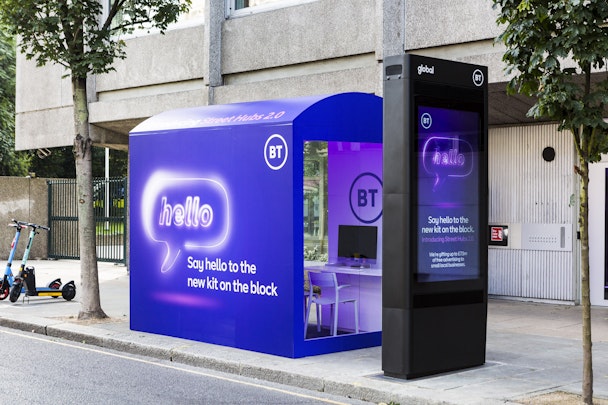‘Watch this space!’: BT on how interactive Street Hub 2.0 fits into OOH media mix
BT last week revealed its next generation of out-of-home (OOH) apparatus, the Street Hub 2.0, with promises to serve local communities as well as serve them ads – with an emphasis on local business. James Browne, head of BT’s Street business, talked The Drum through the launch.

Throughout the year 300 new BT Street Hub 2.0 units will be distributed across the UK
Two Street Hub 2.0s have already been rolled out in Kensington and Chelsea, and throughout the year 300 new units will be distributed across London, Glasgow, Cardiff, Nottingham, Birmingham, Solihull and Southampton.
James Browne, head of Street at BT, reveals they bring free ultra-fast wifi and phone calls, rapid device charging, ‘wayfinding’ (interactive map), CO2 sensors and real-time information (5% of screen time goes to the council). Additionally, there’s £7.5m of free advertising space going to local businesses.
Another benefit the larger unit has over its predecessor is that it can have 4G/5G masts installed to boost busy city hotspots. Browne points out from an advertising perspective it offers a “larger creative canvas” on its digital screen.
There’s also been more thought gone into the placement of the new sites. “The hand-selected locations combined with the hyper-local nature of the Street Hub means advertisers can be incredibly targeted, maximizing reach and engagement at point of sale.” Essentially, these will always be placed in proximity to the high street.
What the Street Hub 2.0 adds
Ahead of the launch, BT surveyed more than 1,000 local businesses to gauge the appetite for the local advertising the hub offers. 60% of small firms believe local advertising would boost awareness of their business, and 40% said it would encourage more people to shop on their local high street. And then came the crux – almost half (49%) said that cost was a major obstacle to them investing in local advertising. The Hub solves a lot of problems, but will it be affordable to said advertisers facing a crunch as we navigate out of Covid-19?
BT says the units will fuel local economies, drive digital inclusion (with free connectivity) and is climate-conscious (thanks to air quality and CO2 sensors). The digital screens provide a strong canvas for public information. During the Covid-19 pandemic, the 400 existing Street Hubs displayed key public health messages.
To stoke interest from local businesses, a competition is being held around each of the local units until the end of March 2022. Winners will receive a two-week ad spot.
Browne says: “The free digital services provided by our Street Hub units can play an important role in helping to revive the UK’s high streets following the pandemic.”
At the time of publishing, there are 491 live Street Hub units. Two of these are 2.0 units, although over the next year that will increase by 300, adding to some 14,000 kiosks with ad inventory across the UK.
Ad opportunities
The hardware is driven by several partnerships. Manchester-based supplier ADXBA handles the software, while Global serves as the digital advertising partner.
Brands can purchase Street Hub inventory programmatically through Global’s digital advertising exchange DAX. Buyers are encouraged to consider contextually relevant creative.
Whether that’s pointing viewers to local shops (Tesco, 200 yards to the right) or an official sponsor activating on the win of a local football team with a discount, marketers are considering how to use these screens in real-time. For BT, there’s a sense in making these units as useful as possible. They can garner the attention a standard OOH placement couldn’t.
Browne says: “We work with a variety of partners to share relevant local content such as news or weather updates. For example, we display LBC news in London.” By slipping in vital updates, news and more, BT is training the public to stare at its screens where they might otherwise not.
And then there’s the free connectivity that mobile users can take advantage of. Having a network of mobiles connected to these Hubs provides another in-device advertising opportunity. However, Browne says: “We don’t currently have any specific plans to push ads to consumers using the free connectivity.”
Asked what innovations are coming to the Hubs, he makes a surprise prediction around QR Codes. Before the new hubs are unveiled, at select sites members of the public can snap a QR code to get a sneak preview of the unit before it is revealed.
“We also frequently utilize QR codes when working with brands on adverts to help drive engagement.” From the camera, viewers can be dragged into AR experiences, immediately buy the product they are seeing or claim a voucher. Now that the public is more used to the QR technology, Browne is enthused about how it could interact with the OOH medium.
“We’re looking forward to working with brands on a myriad of creative executions – watch this space!"

